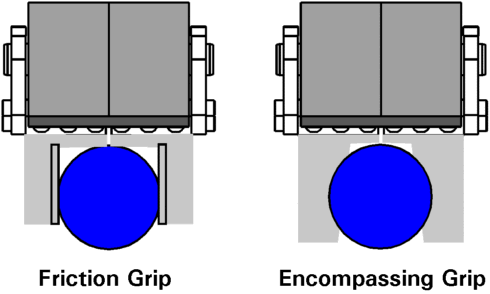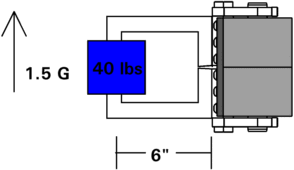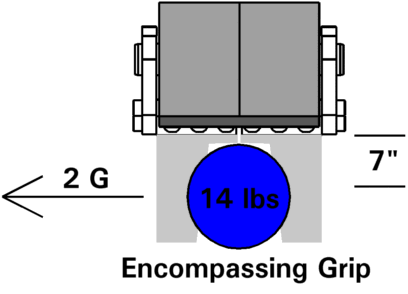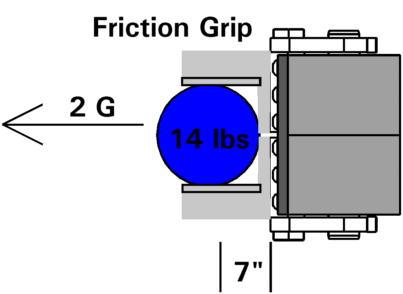

By: Ted Zajac, Jr.
President of ZAYTRAN, Inc.
The force that a robotic gripper applies to a part is typically used by engineers to select grippers. While gripper force is a first order consideration, the torque that is experienced by the gripper is equally as critical and, unfortunately, usually only addressed in a cursory manner. In some cases the torque is addressed via the gripper manufacturer supplying jaw length vs. force charts. These gripper charts are helpful but are only useful in low G-force applications and provide rough guidance at best. The result of this situation is that “rookie” gripper application engineers end up with dropped parts and “old hands” end up with grippers far larger and more expensive than required. Before we start let's look at some of the lore that is wrong!
Gripper Myths
1+1=1?
The first myth that must be exposed is: 1+1=2. In the case of grippers, 10 pounds of force from each jaw delivers a total of 10 pounds of force to the part, or 1+1=1. In essence, half of the force provided by each jaw is used to counteract the other jaw. There are four ways to prove this:
1. Do a free-body analysis (drag out that statics text).
2. Put a force gauge or spring (with a known K) in a gripper jaws and measure.
3. Drop parts.
4. Lean against a wall.
Let us say you are putting 40 pounds of force on the wall. What is the wall doing? It is pushing back with 40 pounds of force or you would have moved it. You are applying 40 pounds of force to the wall so anything trapped between the wall and you will get squeezed with 40 pounds of force.
Now, lean against a friend with 40 pounds of force. He must lean back with 40 pounds of force or get knocked over. You are not doing anything different then when you were leaning against the wall. So, although you and your friend are both leaning with 40 pounds of force, the squeeze is still 40 pounds: 40 + 40 = 40!
After making one of the above experiments it will now be easy to understand that when force is discussed it is the force provided by one jaw.
Gripper Slide Efficiency
The efficiency of a gripper's slide is often provided via a chart that shows jaw length versus force provided. This is an indication of the amount of force actually provided by the gripper versus the theoretical force provided by the pneumatic or electric system. While efficiency is interesting, in most cases it has little to do with the size requirement of a gripper because the slide is equally efficient in both directions. Therefore, if the part is pushing back on the jaw, due to weight or acceleration, the slide will be as efficient or inefficient transmitting this part-created force to the gripper as it is in transmitting the gripper-created force to the part.
Slide efficiency really only comes into play when the gripper jaws are designed so that only a friction grip is provided and “squeeze” is the only thing holding in the part (jaw types and their effect on size requirements are provided in detail later). Typically the slide efficiency charts are only a rough measure of the slide's torque capability. Therefore, while the charts may be helpful, the better gripper manufacturers now provide torque specifications for pitch jaw and roll of the jaws. Bottom line...ask for torque information when sizing a gripper.
Sizing:
What is Needed To Address a Gripper Application
There are two first order elements that must be considered when sizing a gripper, gripper force and slide torque. The requirement for both of these factors must be determined to assure a successful application that will last 10 to 20 million cycles.
Robotic Gripper Force Requirements
Jaw Factor
The style of jaw that is used plays a major roll in determining the force required in a gripper application. There are two types or styles of jaws: Friction or Encompassing. Friction grip jaws rely totally on the force of the gripper to hold the part, the “squeeze” of the gripper does all of the work. Encompassing jaws add stability and power by cradling the part. Encompassing jaws provide a major advantage, 4 to 1, in force required because the jaws must be driven open for a part to be dropped from an encompassing grip. Therefore, the inefficiency of the slides works to help keep the part in place. In the case of the friction grip the jaws need not be moved significantly for the part to fall and a rule of thumb coefficient of friction is .2 to .25.
Example:
Friction Grip: Pick up the bowling ball with your hands completely flat like paddles.
Encompassing Grip: Pick up the bowling ball with your fingers spread and “wrapped” around the ball.
Now, imagine swinging the ball around. It will take a lot more force to keep the ball in place when you are only using your palms. When you wrap your fingers in an encompassing grip less “squeeze” is needed.
While the encompassing style is preferred for strength and stability, the amount that the jaw encompasses the part must be subtracted from the usable stroke. Therefore, as in most technical discussions, there are trade-offs.

The rule of thumb is that a friction grip requires four times the force to handle the same part as an encompassing grip. In the equations that are developed later in this article this translates to a “Jaw Factor” as follows:
Friction Grip Jaw Factor= 4
Encompassing Grip Jaw Factor=1
Part Weight
The next critical factor in determining the required gripper force is the weight of the part that the gripper experiences both from gravity and from acceleration. Often, particularly in robot applications, the acceleration that the robot imparts can be three or four times that which is imparted due to gravity. Thus both “weights” must be considered when determining the gripper force required.
(QUICK SIDE TRIP FOR NON-PHYSICISTS) Speed means nothing to a gripper. High velocity (up to about light speed) is meaningless. ACCELERATION AND DECELERATION mean a lot. Why? When you are traveling in your car at 80 MPH you are comfortable, you only feel discomfort or added weight when you are getting up to speed or stopping. Thus, the faster you start and stop the greater the force that will be experienced. Traveling at a constant velocity, regardless of how fast, puts no force on the object moving. (SIDE TRIP OVER)
Acceleration (how fast the speed changes) means a lot to a gripper. The weight of the part must be multiplied by the number of Gs (earth gravity 1G) to size the gripper.
1 G = 32 feet/sec˛ (9.75 Meters/ sec˛)
Grip Force Required = Part Weight x (1+Part Gs) x Jaw Style factor
Gripper Application Examples:
14 pound bowling ball, friction grip, 1.5 G acceleration from the robot
Grip Force Required=14lbs x (1+1.5) x 4 = 140 pounds
14 pound bowling ball, encompassing grip, 1.5 G acceleration from the robot
Grip Force Required=14lbs x (1+1.5) x 1 = 35 pounds
Robotic Gripper Torque Requirements
Jaw torque is the other critical factor when specifying a gripper. There are two sources of this torque; torque generated by the gripper on itself, and torque generated by the acceleration and weight of the part. These can be addressed separately.
Torque from the robotic gripper
Long Jaws are often required. Either the part is bulky, like an engine block, or the part must be held at a distance to fit in a machine. In either case, the longer the jaw the greater the torque the gripper imposes on itself. Therefore, the torque from the grippers is; GRIPPER TORQUE=Gripper Force x Jaw Length (where jaw length is measured from the face of the gripper to the center of gravity of the part).
Gripper Example:

If we put 6” long jaws on a gripper with 100 pounds of closing force gripper (e.g. MAGNUM-450) the jaws will see:
Jaw Torque= 100 Pounds x 6”= 600 in-pounds.
The rating on the gripper is 840 in-pounds. We used the majority of this rating without even gripping a part because of the length of the jaws!
Thus we can see that the length of the jaws plays a major factor in specifying a gripper. The next task is to determine the torque the gripper will experience from the part.
How Torque From the Part Effect the Gripper
Part torque is essentially acceleration (Gs) x part weight x jaw length. In the following case the acceleration is not in the “up-down” direction so the G force from gravity need not be considered for this example.

We know that acceleration adds force. It also adds torque in addition to the force that the gripper exerts.
In the application above a robot is moving with 1.5G acceleration. The jaw torque becomes:
Part Torque= 6” X 40 lbs X 1.5 G
= 360 in-pounds
However, if the acceleration of the robot is as shown below, one G must be added because gravity will also be trying to torque the jaws.

Part Torque= 6” X 40 Lbs X 2.5 G
= 600 in-pounds
The Torque Summed up
The total torque that the gripper will see is the addition of the Jaw Torque and the Part Torque. In equation form it looks like:
Total Torque=
Jaw Length X Gripper Force + Jaw Length* X Part Weight X (Acceleration + 1G if Up and Down)
* This is an approximation. The distance from the jaw face to the CG of the part should be used.
Gripper Examples

1) Grip Force Required = Part Weight x (1+Part Gs) x Jaw Style factor
Grip Force Required = 14 pounds x 3 x 1 = 42 pounds
2) Jaw Torque = Jaw Length x Grip Force
Jaw Torque = 7” x 42 pounds = 294 in-pounds
3) Part Torque= Jaw Length x Part weight x Acceleration
Part Torque = 7” x 14 pounds x 2 = 196 in-pounds
4) Total Torque = Jaw Torque + Part Torque
Total Torque = 294 in-pounds + 196 in-pounds = 490 in-pounds
5) Specifications: 42 Pounds of grip force, 490 in-pounds of torque

1) Grip Force Required = Part Weight x (1+Part Gs) x Jaw Style factor
Grip Force Required = 14 pounds x 3 x 4 = 168 pounds
2) Jaw Torque = Jaw Length x Grip Force
Jaw Torque = 7” x 168 pounds= 1178 in-pounds
3) Part Torque= Jaw Length x Part weight x Acceleration
Part Torque = 7” x 14 pounds x 2 = 196 in-pounds
4) Total Torque = Jaw Torque + Part Torque
Total Torque = 1178 in-pounds + 196 in-pounds = 1374 in-pounds
5) Specifications: 168 Pounds of grip force, 1374 in-pounds
Gripper Summary
In summary, the major factors that influence the specification for a robotic gripper are jaw style, jaw length and acceleration. The intent of this article was to provide you with a feel for gripper sizing and some of the basic tools. If you have a tough application contact ZAYTRAN. We will run the application through our database and provide you with the technical requirements that match your application.
|
|
|
Call us at 440-324-2814 : FAX 440-324-3552 email info.zaytran@gmail.com PO Box 1660 : Elyria, Ohio 44036 U.S.A. © Copyright ZAYTRAN, Inc All Rights Reserved. MAGNUM and XRAY Are Registered Trademarks of ZAYTRAN, Inc.
Grippers Home |
Magnum Grippers
|
GPAL
Grippers
|
XRAY-S Long Stroke Grippers |